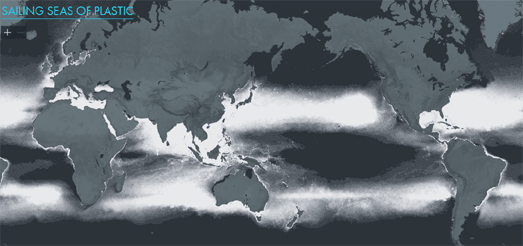
The Seas of Plastic is a visualization of the floating plastic debris that is polluting the world's oceans. The visualization includes an interactive globe showing the five large circulating gyres of plastic in the North Pacific, North Atlantic, Indian, South Atlantic and North Atlantic oceans. The visualization also includes a Sankey Diagram that shows the amount of plastic debris which different countries contribute to each of these five circulating gyres.
The data for the Seas of Plastic visualization comes from a Lagrangian particle tracking model which simulated 30 years of input, transport and accumulation of floating plastic debris around the world. The model tracks the paths of plastic particles from land to sea and estimates the relative size of each of the five circulatory gyres.

Around 8 million tonnes of plastic is dumped into the world's oceans every single year. This plastic is dangerous to marine life and, once it enters the food chain, ultimately dangerous to the health of the human race.
The Ocean Cleanup organisation believes that between 1.15 and 2.41 million metric tons of the plastic in the oceans originates from the world's river systems. Two thirds of it from the rivers of Asia. To help explain how and where plastic ends up in the world's oceans the Ocean Cleanup has released an interactive map, River Plastic Emissions to the World’s Oceans.
The map shows river systems around the globe. The predicted input from each river system is shown at the coast using scaled circular markers. These predicted inputs are based on a model which looks at population density, waste management, topography, hydrography, the locations of dams and the reported concentration of plastic in rivers around the world.

You can see where all that plastic goes on Sailing Seas of Plastic, an interactive mapped visualization of the concentration of plastic in the world's oceans. According to the map there are 5,250 billion pieces of plastic adrift on the seas of the world.
This dot density map shows the estimated concentration of floating plastic in the oceans. Each dot on the map represents 20 kg of floating plastic. The estimations are based on the results of 24 survey expeditions (2007-2013) and on wind and ocean drift models.
If you want you can also overlay the sailing tracks of the 24 survey expeditions on top of the dot map.

No comments:
Post a Comment